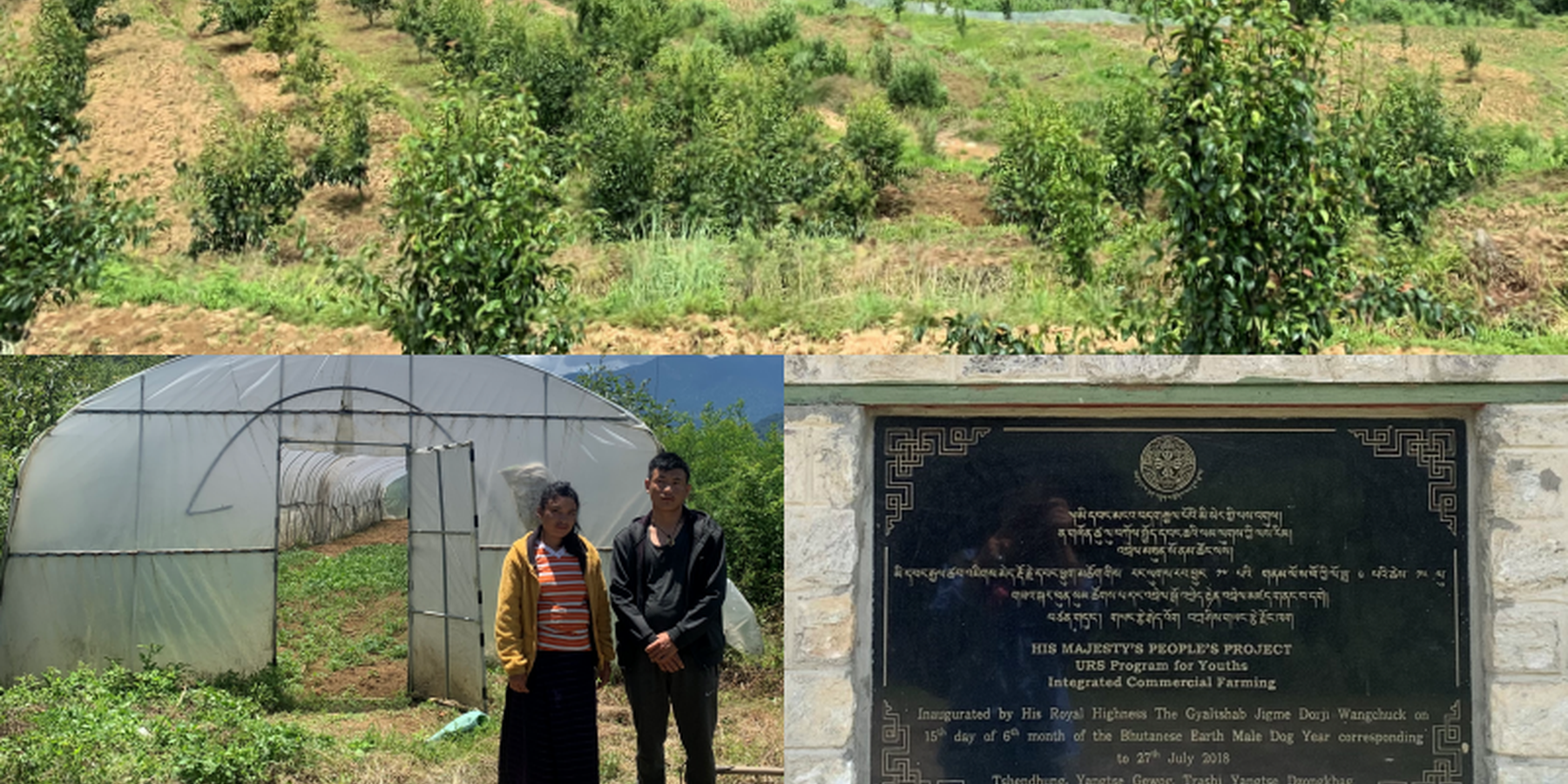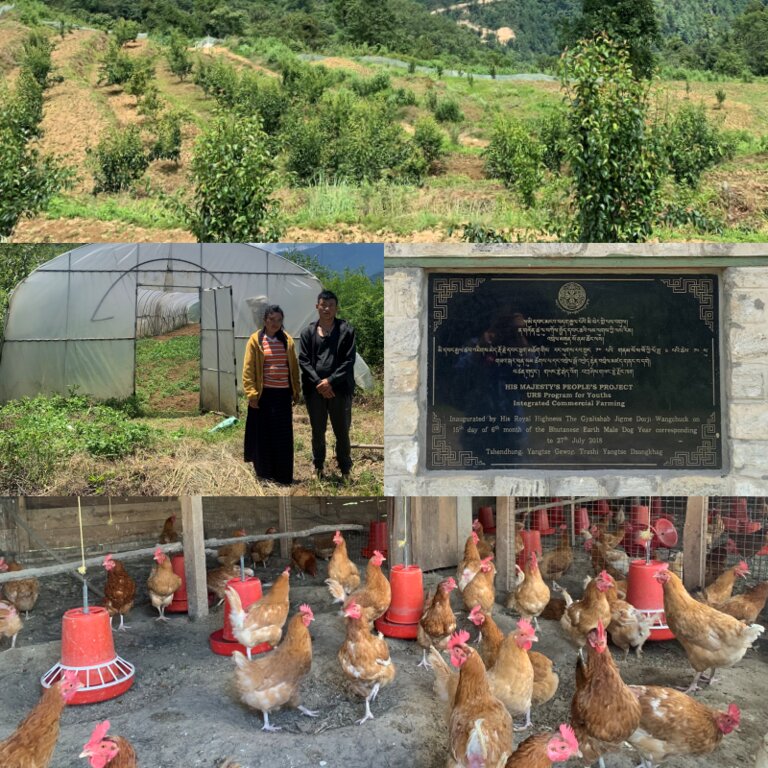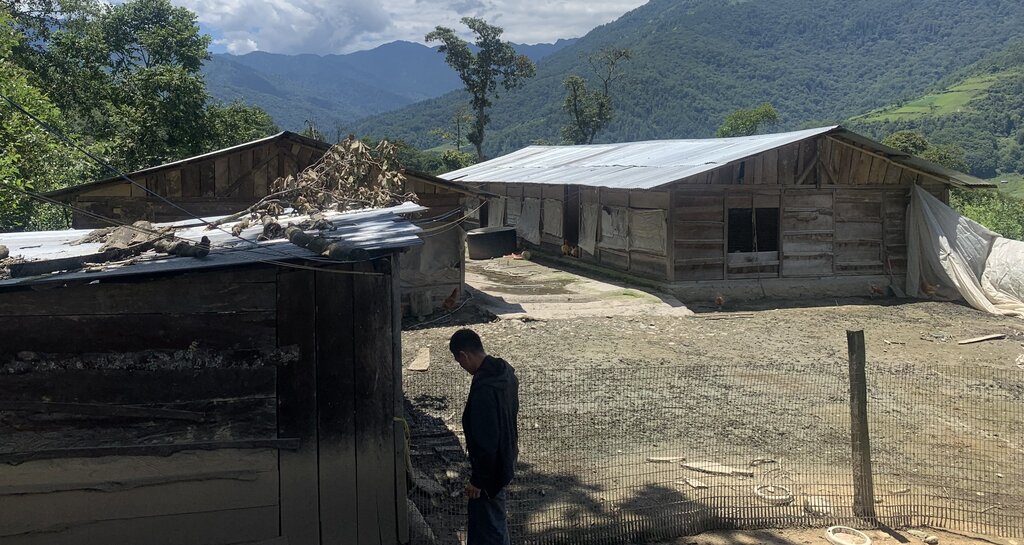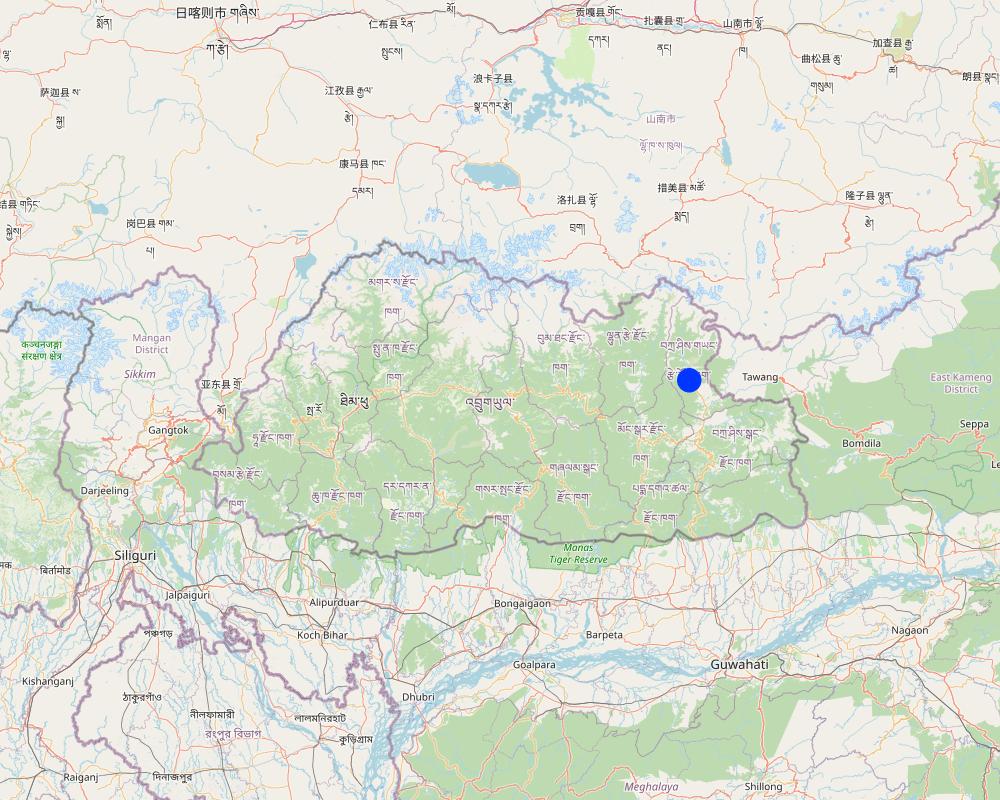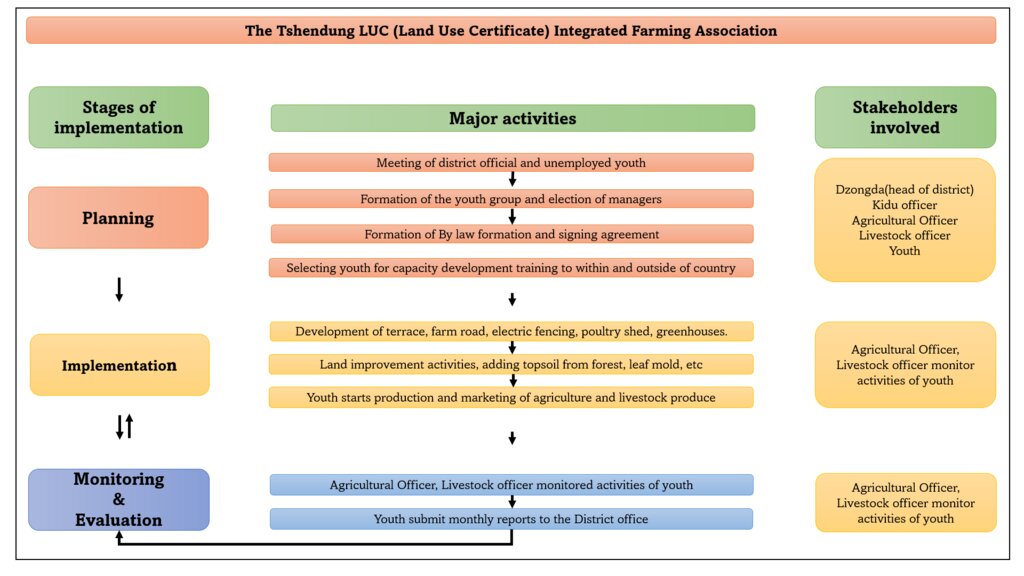Land Use Certificate to engage youth in Agriculture [ບູຕານ]
- ການສ້າງ:
- ປັບປູງ:
- ຜູ້ສັງລວມຂໍ້ມູນ: ONGPO LEPCHA
- ບັນນາທິການ: chenga Tshering
- ຜູ້ທົບທວນຄືນ: William Critchley, Rima Mekdaschi Studer
'Sa cha Kelchay Lakher'
approaches_6886 - ບູຕານ
ເບິ່ງພາກສ່ວນ
ຂະຫຍາຍທັງໝົດ ຍຸບທັງໝົດ1. ຂໍ້ມູນທົ່ວໄປ
1.2 ລາຍລະອຽດ ການຕິດຕໍ່ ຂອງບຸກຄົນທີ່ຊັບພະຍາກອນ ແລະ ສະຖາບັນ ການມີສ່ວນຮ່ວມ ໃນການປະເມີນຜົນ ແລະ ເອກະສານ ຂອງວິທີທາງ
ບຸກຄົນສຳຄັນ (ຫຼາຍຄົນ)
ຜູ້ນໍາໃຊ້ທີ່ດິນ:
Tenzin Kuenzang
17582178
Tshendung, Lichen Chiwog, Yangtse gewog
ບູຕານ
ຜູ້ນໍາໃຊ້ທີ່ດິນ:
Wangmo Sither
17459445
Tshendung, Lichen Chiwog, Yangtse gewog
ບູຕານ
ຊື່ຂອງໂຄງການ ທີ່ອໍານວຍຄວາມສະດວກ ໃນການສ້າງເອກກະສານ ຫຼື ປະເມີນດ້ານແນວທາງ (ຖ້າກ່ຽວຂ້ອງ)
Strengthening national-level institutional and professional capacities of country Parties towards enhanced UNCCD monitoring and reporting – GEF 7 EA Umbrella II (GEF 7 UNCCD Enabling Activities_Umbrella II)ຊື່ຂອງ ສະຖາບັນການຈັດຕັ້ງ ທີ່ອໍານວຍຄວາມສະດວກ ໃນການສ້າງເອກກະສານ ຫຼື ປະເມີນແນວທາງ (ຖ້າກ່ຽວຂ້ອງ)
National Soil Services Centre, Department of Agriculture, Ministry of Agriculture & Livestock (NSSC) - ບູຕານ1.3 ເງື່ອນໄຂ ຂອງການນໍາໃຊ້ເອກກະສານຂໍ້ມູນ ຂອງ WOCAT
ເມື່ອໃດທີ່ໄດ້ສັງລວມຂໍ້ມູນ (ຢູ່ພາກສະໜາມ)?
19/07/2023
ຜູ້ສັງລວມ ແລະ ບັນດາຜູ້ຕອບແບບສອບຖາມ ຍອມຮັບໃນເງື່ອນໄຂ ການນໍາໃຊ້ຂໍ້ມູນເອກະສານ ທີ່ສ້າງຂື້ນ ໂດຍຜ່ານ ອົງການ WOCAT:
ແມ່ນ
2. ພັນລະນາ ແນວທາງການຄຸ້ມຄອງນໍາໃຊ້ດິນແບບຍືນຍົງ
2.1 ການອະທິບາຍ ໂດຍຫຍໍ້ ຂອງວິທີທາງ
The Land Use Certification (LUC) commenced in 2015 as the new allocation system for land and provided a new title of land tenure. Initially, LUC focused on allotting land to Government institutions and Gerab Dratshang (monastic bodies). However, LUC later focused on the unemployed youth who were interested in commercial farming.
2.2 ການອະທິບາຍ ລາຍລະອຽດ ຂອງວິທີທາງ
ການອະທິບາຍ ລາຍລະອຽດ ຂອງວິທີທາງ:
The Land Use Certification (LUC) commenced in 2015 as the new system for the allocation of land and a new title of land tenure. Initially, LUC focused on allotting land to Government institutions and Gerab Dratshang (monastic bodies). However, LUC later focused on the unemployed youth who were interested in commercial farming. This documentation is based on the LUC group ‘Tshendung LUC Integrated Farming Association'.
The main aims of the LUC approach are 1) to help sustainably manage and enhance productive use of land, 2) to encourage next-generation farming through farm mechanization and large-scale enterprising farming, and 3) to enhance the rural economy.
The approach started as an initiative towards the realization of the noble vision of strengthening sovereignty and security and enhancing social policy of equity and the national objective of self-reliance. Unemployed youth groups are expected to help sustainably manage and enhance the productive use of land - and the approach was to encourage next-generation farming through farm mechanization and large-scale production to promote enterprise-based farming and enhance the rural economy. Initially, it started with a meeting between district officials and unemployed youth. Later, bylaws were created, and agreements were signed. This was followed by sending youth for capacity development within and outside the country. They were trained on how to operate power tillers, use grass cutters and chain saws, and on the installation of electric fencing and greenhouses. In addition, they were trained in how to grow vegetables, fruit crops, and livestock production. In parallel infrastructure development activities were taking place in the current project sites.
The Tshendung LUC Integrated Farming Association enables land users to carry out agricultural activities more effectively. In addition, the association was able to transport and market their produce more efficiently than individual households. Other co-benefits reported are the improved community sense and enhanced social cohesion because the exchange of experiences and collaboration builds mutual trust. Working in a group eases hard physical work on the 9 acres (3.6 ha) of land.
The District Office initiated the group formation upon command from higher authority. They were also involved in planning, forming groups, bylaws, and monitoring the activities of the group. The District agricultural and livestock officers provided technical guidance on crop and livestock production. They also provided them with agricultural inputs. Lichen Primary School are consumers of the agricultural and livestock goods produced by the group. Land users are involved in planning the production and marketing of agricultural and animal products.
Initially, there were 11 youths in the group. They were provided with wide-ranging training and support including the preparation of land for growing crops and the construction of their residence. In addition to agricultural inputs like seeds, and saplings, the group was also provided farm machinery and farm tools for easy implementation of farm works. The group is happy with all the initiatives the government has done, however, one thing that discouraged the group from continuing with farming activities was the location of the site. They didn't like the location - which is in the middle of the forest around 15-20km away from the town. This makes transportation of agricultural inputs like seeds and feeds and marketing of agricultural and livestock products very difficult. The government initially supported the group with everything but later this support was withdrawn, which made it very difficult for the group to survive on their own.
2.3 ຮູບພາບຂອງແນວທາງ
2.5 ປະເທດ / ເຂດ / ສະຖານທີ່ບ່ອນທີ່ແນວທາງໄດ້ຖືກນໍາໃຊ້
ປະເທດ:
ບູຕານ
ພາກພື້ນ / ລັດ / ແຂວງ:
Lichen, Trashi Yangtse: Bhutan
ຂໍ້ມູນເພີ່ມເຕີມຂອງສະຖານທີ່:
Tshendung, Lichen chiwog (village), Yangtse gewog (sub district): Trashi Yangtse Dzongkhag (District)
Map
×2.6 ວັນທີເລີ່ມຕົ້ນ ແລະ ສິ້ນສຸດ ການຈັດຕັ້ງປະຕີບັດ ວິທີທາງ
ສະແດງປີຂອງການເລີ່ມຕົ້ນ:
2015
ຖ້າຫາກບໍ່ຮູ້ຈັກປີທີ່ແນ່ນອນ, ໃຫ້ປະມານຄາດຄະເນ ເອົາມື້ທີ່ໄດ້ເລີ່ມຈັດຕັ້ງປະຕິບັດ ວິທີທາງ:
ຕໍ່າກວ່າ 10 ປີ ຜ່ານມາ (ມາເຖິງປະຈຸບັນ)
ຄວາມຄິດເຫັນ:
The Land Use Certification (LUC) is an initiative commenced in 2015 as the new allotment system of land and a new title of land tenure.
2.7 ປະເພດຂອງແນວທາງ
- ການລິເລີ່ມ ພາຍໃນປະເທດ ທີ່ຜ່ານມາ / ນະວັດຕະກໍາ
2.8 ເປົ້າໝາຍ / ຈຸດປະສົງຫຼັກ ຂອງການຈັດຕັ້ງປະຕິບັດ ວິທີທາງ
The main aims/objectives of the approach are to 1) foster youth entrepreneurship in the country, 2) promote, foster, encourage, and assist the efficient, convenient marketing and distribution of agricultural products, livestock, and associated by-products with the growing market within Trashi Yangtse and other districts in the country.
2.9 ເງື່ອນໄຂອໍານວຍ ຫຼື ຂັດຂວາງການປະຕິບັດຂອງເຕັກໂນໂລຢີ / ເຕັກໂນໂລຢີການນໍາໃຊ້ຕາມແນວທາງ
ສັງຄົມ / ວັດທະນະທໍາ / ມາດຕະຖານ ແລະ ຄຸນຄ່າທາງສາສະໜາ
- ອໍານວຍ
Land users are generally from the same local ethnic groups called Yangtsepa. They shared the same social, cultural, religious, norms and values. Gender equality is considered and importance and priority is given equally.
ມີຄວາມສາມາດ / ເຂັ້າເຖິງຊັບພະຍາກອນດ້ານການເງິນ ແລະ ການບໍລິການ
- ເຊື່ອງຊ້ອນ
Initially, land users were provided all required support by the project including financial support, however, when the land users started implementing and working on the approach own their own. Getting financial support was difficult.
ການກໍ່ຕັ້ງສະຖາບັນ
- ເຊື່ອງຊ້ອນ
Initially, there were 11 land users involved, however, today only two of the land users are active. Shortage of human resources hinders production and this result in low profit.
ການຮ່ວມມື / ການປະສານງານຂອງຜູ້ກ່ຽວຂ້ອງ
- ເຊື່ອງຊ້ອນ
Although the land users are able to produce a certain quantity of vegetables there are not many collaborators willing to buy their produce. They also lack a farm manager who can dedicate 100% of his time in marketing and finding collaborators.
ຄວາມຮູ້ກ່ຽວກັບການຄຸ້ມຄອງ ທີ່ດິນແບບຍືນຍົງ, ການເຂົ້າເຖິງການສະໜັບສະໜູນ ທາງດ້ານວິຊາການ
- ອໍານວຍ
Technical support related to agriculture and livestock is provided by the District Agriculture officer and livestock officers. Inputs like seeds are also freely provided by the district. The activities are also monitored by the officers and advices are given if land users are doing thing wrongly.
ຕະຫຼາດ (ໃນການຊື້ວັດຖຸດິບ, ຂາຍຜະລິດຕະພັນ) ແລະ ລາຄາ
- ເຊື່ອງຊ້ອນ
The site of the approach is located very far from the market. The size of the market is very small with lots of other competitors like farmers groups i.e., Vegetable group, milk group, etc. And due to this competition, the prices the land users get are very low.
ວຽກ, ມີກໍາລັງຄົນ
- ເຊື່ອງຊ້ອນ
Totally, there are about 9 acres of land and there are only two land users who are active and working in the land. The workload is too much and this affects their production.
3. ການມີສ່ວນຮ່ວມ ແລະ ບົດບາດຂອງພາກສ່ວນທີ່ກ່ຽວຂ້ອງທີ່ໄດ້ມີສ່ວນຮ່ວມ
3.1 ຜູ້ມີສ່ວນຮ່ວມ ໃນວິທີທາງ ແລະ ພາລະບົດບາດ ຂອງເຂົາເຈົ້າ
- ຜູ້ນໍາໃຊ້ດິນໃນທ້ອງຖິ່ນ / ຊຸມຊົນທ້ອງຖິ່ນ
Youth from local communities
They are the land users on the project site.
- ຜູ້ຊ່ຽວຊານ ການນຄຸ້ມຄອງ ທີ່ດິນແບບຍືນຍົງ / ທີ່ປຶກສາດ້ານກະສິກໍາ
District Agriculture and Livestock officers
Advisors: All technical supports related to the production of crops and livestock are provided by these officers.
- ຄູອາຈານ / ນັກຮຽນ / ນັກສຶກສາ
Lichen Primary School
Consumers: Vegetables produced by the land users are sold to the school.
- ພະນັກງານຂັ້ນສູນກາງ (ຜູ້ວາງແຜນ, ຜູ້ສ້າງນະໂຍບາຍ)
District head office
Decision makers: provide technical support and financial support. involved in the planning and implementation of the activities under the approach.
3.2 ການມີສ່ວນຮ່ວມຂອງຜູ້ນໍາໃຊ້ທີ່ດິນໃນທ້ອງຖິ່ນ / ຊຸມຊົນທ້ອງຖິ່ນໃນໄລຍະທີ່ແຕກຕ່າງກັນຂອງແນວທາງ
| ການລວບລວມ ເອົາຜູ້ນໍາໃຊ້ດິນ ໃນທ້ອງຖິ່ນ / ຊຸມຊົນທ້ອງຖິ່ນ | ໃຫ້ລະບຸ ຜູ້ໃດທີ່ມີສ່ວນຮ່ວມ ໃນແຕ່ລະກິດຈະກໍາ? | |
|---|---|---|
| ການເລີ່ມຕົ້ນ / ແຮງຈູງໃຈ | ການຊ່ວຍເຫຼືອຈາກພາຍນອກ | District officer, Kidu officer directed the youths on the opportunity through this approach. |
| ການວາງແຜນ | ການຮ່ວມມື | The district officer, engineer, agricultural and livestock extension officer, head of the gewog/block, and land users identified the place and started the planning. |
| ການປະຕິບັດ | ການຮ່ວມມື | The district engineer started the land development activities by creating a terrace and farm road. This was later followed by agricultural and livestock activities. |
| ຕິດຕາມກວດກາ / ການປະເມີນຜົນ | ການຮ່ວມມື | Focal person for LUC Agriculture extension officer Livestock extension officer District legal officer |
3.3 ແຜນວາດ (ຖ້າມີ)
ການອະທິບາຍ:
Flow chart of the major events that took place before youth started taking care of the land. Also indicates different phase of approach and stakeholders involved.
ຜູ້ຂຽນ:
Ongpo Lepcha
3.4 ການຕັດສິນໃຈກ່ຽວກັບການຄັດເລືອກເຕັກໂນໂລຢີຂອງການຄຸ້ມຄອງທີ່ດິນແບບຍືນຍົງ / ເຕັກໂນໂລຢີ
ລະບຸ ຄົນທີ່ຕັດສິນໃຈ ກ່ຽວກັບການຄັດເລືອກຂອງ ເຕັກໂນໂລຢີ / ເຕັກໂນໂລຢີ ຈະໄດ້ຮັບການປະຕິບັດ:
- ຜູ້ນໍາໃຊ້ດິນຜູ້ດຽວ (ການລິເລີ່ມດ້ວຍຕົນເອງ)
ອະທິບາຍ:
Initially, a part of electric fencing was done by the government, and later the group installed a part of greenhouse. Chicken manure and leaf mould, and top soil from the forest were collected and applied.
Specify on what basis decisions were made:
- ປະສົບການສ່ວນບຸກຄົນ ແລະ ຄວາມຄິດເຫັນ (ທີ່ບໍ່ເປັນເອກກະສານ)
4. ການສະໜັບສະໜູນທາງດ້ານວິຊາການ, ການສ້າງຄວາມສາມາດ, ແລະ ການຈັດການຄວາມຮູ້.
4.1 ການສ້າງຄວາມສາມາດ / ການຝຶກອົບຮົມ
ຜູ້ນໍາໃຊ້ທີ່ດິນ ຫຼື ພາກສ່ວນກ່ຽວຂ້ອງອື່ນໆ ໄດ້ຮັບການຝຶກອົບຮົມບໍ່?
ແມ່ນ
ໃຫ້ລະບຸ ຜູ້ໃດທີ່ໄດ້ຮັບການຝຶກອົບຮົມ:
- ຜູ້ນໍາໃຊ້ດິນ
ຖ້າເປັນໄປໄດ້, ໃຫ້ລະບຸເພດ, ອາຍຸ, ສະຖານະພາບ, ຊົນເຜົ່າ, ແລະ ອື່ນໆ:
10 males and a female were trained. They were all under the age of 25.
ຮູບແບບຂອງການຝຶກອົບຮົມ:
- ຕົວຕໍ່ຕົວ
- ເນື້ອທີ່ສວນທົດລອງ
ໃນຫົວຂໍ້:
Production of fruits and vegetables, Poultry and dairy production, Power tiller operation, and record keeping.
ຄວາມຄິດເຫັນ:
Land users were sent to India for the site visit to explore and learn about poultry production, dairy production, and vegetable and fruit production. Some of them attended training on how to operate power tillers.
4.2 ການບໍລິການໃຫ້ຄໍາປຶກສາ
ເຮັດຜູ້ໃຊ້ທີ່ດິນມີການເຂົ້າເຖິງການບໍລິການໃຫ້ຄໍາປຶກສາ?
ແມ່ນ
ລະບຸວ່າການສະໜອງ ການບໍລິການ ໃຫ້ຄໍາປຶກສາ:
- ໃນພື້ນທີ່ຂອງຜູ້ນໍາໃຊ້ດິນ
- ສູນຄົ້ນຄວ້າ
ອະທິບາຍ / ຄວາມຄິດເຫັນ:
The agricultural extension officer and livestock officer provided advice on what crop to grow, and what livestock to rear.
4.3 ສະຖາບັນການສ້າງຄວາມເຂັ້ມແຂງ (ການພັດທະນາອົງການຈັດຕັ້ງ)
ສະຖາບັນ ໄດ້ຮັບການສ້າງຕັ້ງຂື້ນ ຫຼື ໄດ້ຮັບການສ້າງຄວາມເຂັ້ມແຂງ ໂດຍການຈັດຕັ້ງປະຕິບັດ ວິທີທາງບໍ່?
- ມີ, ພໍສົມຄວນ
ລະບຸ ທາງສະຖາບັນ ໄດ້ສ້າງຄວາມເຂັ້ມແຂງ ໃນລະດັບໃດ (ຫຼາຍ):
- ທ້ອງຖິ່ນ
ອະທິບາຍ ສະຖາບັນການຈັດຕັ້ງ, ພາລະບົດບາດ ແລະ ໜ້າທີ່ຮັບຜິດຊອບ, ສະມາຊິກ ແລະ ອື່ນໆ.
Institutional strengthening between the group and the Lichen Primary School was strengthened. Here the group is a producer of vegetables, butter, and cheese and the school is the buyer.
4.4 ຕິດຕາມກວດກາ ແລະ ປະເມີນຜົນ
ການຈັດຕັ້ງປະຕິບັດ ວິທີທາງ ໄດ້ມີການປະເມີນຜົນ ແລະ ຕິດຕາມບໍ?
ແມ່ນ
ຄວາມຄິດເຫັນ:
Crop and livestock production were monitored through observation by the agricultural officer and livestock officer.
ຖ້າແມ່ນ, ເອກກະສານສະບັບນີ້ ແມ່ນໄດ້ນໍາໃຊ້ເຂົ້າໃນການຕິດຕາມ ແລະ ປະເມີນຜົນບໍ່?
ແມ່ນ
4.5 ການຄົ້ນຄວ້າ
ນີ້້ແມ່ນສ່ວນໜຶ່ງ ການຄົ້ນຄວ້າ ຂອງວິທີທາງບໍ່?
ແມ່ນ
ລະບຸ ຫົວຂໍ້:
- ເສດຖະສາດ / ການຕະຫຼາດ
- ເຕັກໂນໂລຢີ
ໃຫ້ຂໍ້ມູນ ເພີ່ມເຕີມ ແລະ ກໍານົດ ຜູ້ໃດເຮັດການຄົ້ນຄວ້າ:
The research was conducted to study the feasibility of different vegetables in different seasons. Trials were conducted and land users found out that most vegetables don't do well except vegetables like cabbage, beans, and chilli.
5. ການສະໜັບສະໜູນທາງດ້ານການເງິນ ແລະ ອຸປະກອນຈາກພາຍນອກ
5.1 ງົບປະມານປະຈໍາປີ ສໍາລັບວິທີທາງ ຂອງການຄຸ້ມຄອງ ທີ່ດິນແບບຍືນຍົງ
ຄໍາເຫັນ (ຕົວຢ່າງ: ແຫຼ່ງຂໍ້ມູນຫຼັກ ຂອງການສະໜອງທຶນ / ຜູ້ໃຫ້ທຶນທີ່ສໍາຄັນ):
There is no budget allocated for any SLM technologies in this approach. All financial needs were met by the project.
5.2 ການສະໜັບສະໜູນ ທາງດ້ານການເງິນ / ອຸປະກອນ ສະໜອງໃຫ້ແກ່ຜູ້ນໍາທີ່ດິນ
ຜູ້ນໍາໃຊ້ດິນ ໄດ້ຮັບການສະໜັບສະໜູນ ທາງດ້ານ ການເງິນ / ອຸປະກອນ ໃນການຈັດຕັ້ງປະຕິບັດ ເຕັກໂນໂລຢີບໍ?
ແມ່ນ
ຖ້າແມ່ນ, ໃຫ້ລະບຸປະເພດ (ຫຼາຍ) ຂອງການສະໜັບສະໜູນ, ເງື່ອນໄຂ ແລະ ຜູູ້ສະໜອງ (ຫຼາຍ):
Construction support: Road constructed by project, land development done by project
Constructional material support: Electric fencing, housing, Irrigation, greenhouse, power tillers, power chain, grass cutter, wheelbarrow, secateurs, spades, shovels, etc.
5.3 ເງິນສົມທົບສໍາລັບການນໍາໃຊ້ສະເພາະປັດໃຈຂາເຂົ້າໃນການຜະລີດກະສິກໍາ (ລວມທັງແຮງງານ)
- ອຸປະກອນ
| ໃຫ້ລະບຸໄດ້ຮັບການສະໜັບສະໜູນປັດໃຈຂາເຂົ້າຫຍັງແດ່ | ທີ່ຂອບເຂດ | ລະບຸ ການອຸດໜູນ |
|---|---|---|
| ເຄື່ອງກົນຈັກ | ງົບປະມານເຕັມສ່ວນ | The cost for 3 power tillers, 3 power tillers, 3 grass cutters, and 1 chaffer is all provided by the project for free. |
| ເຄື່ອງມື | ງົບປະມານເຕັມສ່ວນ | Tools like spades, secateurs, shovels, spade, sickle, rake, pruning saw, wheelbarrow, knife, |
- ກະສິກໍາ
| ໃຫ້ລະບຸໄດ້ຮັບການສະໜັບສະໜູນປັດໃຈຂາເຂົ້າຫຍັງແດ່ | ທີ່ຂອບເຂດ | ລະບຸ ການອຸດໜູນ |
|---|---|---|
| ແນວພັນ, ແກ່ນພັນ | ງົບປະມານເຕັມສ່ວນ | Vegetable seeds were provided free by the project |
| ຝຸ່ນ, ປຸ໋ຍ | ງົບປະມານເຕັມສ່ວນ | Suphala were initially provided for free. |
- ການກໍ່ສ້າງ
| ໃຫ້ລະບຸໄດ້ຮັບການສະໜັບສະໜູນປັດໃຈຂາເຂົ້າຫຍັງແດ່ | ທີ່ຂອບເຂດ | ລະບຸ ການອຸດໜູນ |
|---|---|---|
| ເສັ້ນທາງ | ງົບປະມານເຕັມສ່ວນ | The cost involved in road and land development was paid by the project. |
| House | ງົບປະມານເຕັມສ່ວນ | All materials used for making house and stores were provided by the project. |
- ພື້ນຖານໂຄງລ່າງ
| ໃຫ້ລະບຸໄດ້ຮັບການສະໜັບສະໜູນປັດໃຈຂາເຂົ້າຫຍັງແດ່ | ທີ່ຂອບເຂດ | ລະບຸ ການອຸດໜູນ |
|---|
ຖ້າແຮງງານ ຂອງຜູ້ນໍາໃຊ້ດິນ ໄດ້ຮັບການສະໜັບສະໜູນ ປັດໃຈຂາເຂົ້າ, ແມ່ນບໍ່:
- ໄດ້ຮັບການສະໜັບສະໜູນ ອຸປະກອນດ້ານອື່ນ
ຄວາມຄິດເຫັນ:
Land users (youth) worked in the group for the installation of the greenhouse, electric fencing, construction of a poultry shed, and apartment bungalow for themselves.
5.4 ສິນເຊື່ອ
ໄດ້ປ່ອຍສິນເຊື່ອ ສະໜອງໃຫ້ພາຍໃຕ້ ວິທີການສໍາລັບກິດຈະກໍາ ການຄຸ້ມຄອງ ທີ່ດິນແບບຍືນນຍົງບໍ່?
ບໍ່ແມ່ນ
5.5 ສິ່ງຈູງໃຈ ຫຼື ເຄື່ອງມືອື່ນໆ
ການສົ່ງເສີມ ຈັດຕັ້ງປະຕິບັດ ເຕັກໂນໂລຢີ ໃນການຄຸ້ມຄອງ ດິນແບບຍືນຍົງ ໄດ້ສະໜອງສິ່ງກະຕຸກຊຸກຍູ້ບໍ່?
ແມ່ນ
ຖ້າແມ່ນ, ໃຫ້ລະບຸ:
Land development was carried out under the supervision of the District Agricultural and livestock officers, who are SLM experts at the district level. Greenhouses with simi automated irrigation, terraces with bunds, and electric fencing were promoted as incentives through the project.
6. ວິເຄາະຜົນກະທົບ ແລະ ສັງລວມບັນຫາ
6.1 ຜົນກະທົບຂອງແນວທາງ
ວິທີທາງ ຊ່ວຍຊຸກຍູ້ ຜູ້ນຳໃຊ້ທີ່ດິນທ້ອງຖີ່ນ, ໃນການປັບປຸງ ການມີສ່ວນຮ່ວມ ຂອງຜູ້ທີ່ກ່ຽວຂ້ອງ ບໍ່?
- ບໍ່
- ມີ, ໜ້ອຍໜຶ່ງ
- ມີ, ພໍສົມຄວນ
- ມີ, ຫຼາຍ
Land users received various training which helped them equip with knowledge and skills related to the use of agricultural machinery like power tillers, grass cutters, and chaffer machines. In addition, they also learned how to grow vegetables and fruits scientifically.
ການນໍາໃຊ້ ວິທີທາງ ດັ່ງກ່າວນີ້ ສາມາດເປັນຫຼັກຖານ ທີ່ສະໜັບສະໜູນ ໃຫ້ການຕັດສິນໃຈໄດ້ບໍ່?
- ບໍ່
- ມີ, ໜ້ອຍໜຶ່ງ
- ມີ, ພໍສົມຄວນ
- ມີ, ຫຼາຍ
Land users initially practiced growing crops based on the local communities, however, later they learned to do off-season vegetables using a greenhouse, and the vegetables they grew were all based on the evidence that some vegetables are not doing good in the location.
ການຈັດຕັ້ງປະຕິບັດ ວິທີທາງ ສາມາດຊ່ວຍຜູ້ນໍາໃຊ້ທີ່ດິນ ໃນການຈັດຕັ້ງປະຕິບັດ ແລະ ບໍາລຸງຮັກສາ ເຕັກໂນໂລຢີ ການຄຸ້ມຄອງ ທີ່ດິນແບບຍືນຍົງໄດ້ບໍ?
- ບໍ່
- ມີ, ໜ້ອຍໜຶ່ງ
- ມີ, ພໍສົມຄວນ
- ມີ, ຫຼາຍ
The site of the approach is located away from local communities. Using technologies like electric fencing became very important. The land user also shared their view on aspects and slopes of the land and their activities like maintaining the slope and fertility of the land. Land user also added that they were taught how to grow Napier grass to reduce land degradation.
ການນໍາໃຊ້ ວິທີທາງ ສາມາດປັບປຸງຄວາມຮູ້ ແລະ ຄວາມສາມາດຂອງຜູ້ນໍາໃຊ້ທີ່ດິນ ໃນການປະຕິບັດ ການຄຸ້ມຄອງ ທີ່ດິນແບບຍືດຍົງໄດ້ບໍ່?
- ບໍ່
- ມີ, ໜ້ອຍໜຶ່ງ
- ມີ, ພໍສົມຄວນ
- ມີ, ຫຼາຍ
Land users received various training which helped them equip with knowledge and skills related to the use of agricultural machinery like power tillers, grass cutters, and chaffer machines. In addition, they also learned how to grow vegetables and fruits scientifically. This knowledge and skills indirectly helped them to maintain soil fertility and increase production.
ການຈັດຕັ້ງປະຕິບັດ ວິທີທາງ ສາມາດສ້າງຄວາມເຂັ້ມແຂງ ທາງສັງຄົມ ແລະ ເສດຖະກິດບໍ່?
- ບໍ່
- ມີ, ໜ້ອຍໜຶ່ງ
- ມີ, ພໍສົມຄວນ
- ມີ, ຫຼາຍ
Land users were mostly unemployed youths from nearby villages. They were sons and daughters of socially and economically disadvantaged groups. Some of them had an educational background and some never went to school. The approach have empower this youth very much in term of knowledge and skills.
ການຈັດຕັ້ງປະຕິບັດ ວິທີທາງ ສາມາດຊຸກຍູ້ ຜູ້ນໍາໃຊ້ທີ່ດິນທີ່ເປັນຊາວໜຸ່ມ / ຄົນລຸ້ນໃໝ່ ໃນການຄຸ້ມຄອງ ທີ່ດິນແບບຍືນຍົງໄດ້ບໍ?
- ບໍ່
- ມີ, ໜ້ອຍໜຶ່ງ
- ມີ, ພໍສົມຄວນ
- ມີ, ຫຼາຍ
Land users were mostly youth between the age group of 20 to 30. This indicates that the approach has encouraged young people to engage in SLM.
ການນໍາໃຊ້ ວິທີທາງ ໄດ້ປັບປຸງ ການຈ້າງງານ, ໂອກາດ ໃນການສ້າງລາຍຮັບບໍ່?
- ບໍ່
- ມີ, ໜ້ອຍໜຶ່ງ
- ມີ, ພໍສົມຄວນ
- ມີ, ຫຼາຍ
It was learned that initially when this approach first started there were around 20 youths involved. Many youths have left the group after they have improved their skills and knowledge through the approach. Today many of them have their own farm and business.
6.2 ແຮງຈູງໃຈຫຼັກຂອງຜູ້ນໍາໃຊ້ທີ່ດິນໃນການປະຕິບັດການຄຸ້ມຄອງທີ່ດິນແບບຍືນຍົງ
- ການຜະລິດເພີ່ມຂຶ້ນ
The land user shared that increased agricultural production through the approach motivated them the most. More production means more money for the youth.
- ການຊໍາລະເງິນ / ເງິນອຸດໜູນ
More than the production, payments/subsidies motivated them the most. The project supported them from land preparation to providing capacity development through training and site visits to some international sites.
6.3 ຄວາມຍືນຍົງຂອງກິດຈະກໍາວິທີທາງ
ຜູ້ນໍາໃຊ້ ທີ່ດິນ ສາມາດສືບຕໍ່ ການຈັດຕັ້ງປະຕິບັດ ຜ່ານວິທີທາງໄດ້ບໍ່ (ໂດຍປາດສະຈາກ ການຊ່ວຍເຫຼືອ ຈາກພາກສ່ວນພາຍນອກ)?
- ບໍ່ມີ
ຖ້າ ບໍ່ ຫຼື ບໍ່ແນ່ໃຈ, ໃຫ້ອະທິບາຍ ແລະ ຄໍາເຫັນ:
Initially, many land users were involved in sustaining and implementing the approach. However, later many land users could not continue to be part of the approach. In this case, the present land user said that in the future it will be very difficult to sustain what has been implemented through the approach. This is mainly because different land users were trained in different aspects of the approach. Secondly, the less number of land users involved cannot look after a huge area i.e., 9 acres.
6.4 ຈຸດແຂງ / ຂໍ້ດີ ຂອງວິທີທາງ
| ຈຸດແຂງ / ຂໍ້ດີ / ໂອກາດໃນການນໍາໃຊ້ທີ່ດິນ |
|---|
| Employment: The approach provided employment opportunities to more than 20 youth who were from socially and economically disabled groups. |
| Income: The approach also became the source of income for 20 youths who were involved in the approach. |
| Diversified source of income: With support from the project many technologies were incorporated into the site, like a poultry farm, fruit trees, vegetables, and a greenhouse. These technologies acted as a source of income for the land users. |
| ຈຸດແຂງ / ຈຸດດີ / ໂອກາດ ຈາກທັດສະນະຂອງຜູ້ປ້ອນຂໍ້ມູນ ຫຼື ບຸກຄົນສຳຄັນ |
|---|
| Capacity building and opportunities: Through the approach, land users were trained in different aspects like how to use power tillers, power chains, and grass cutters. livestock rearing, vegetables, and fruit cultivation. Through this training, their knowledge and skills were developed which was plus point as it provided an opportunity to look for better options. |
6.5 ຈຸດອ່ອນ / ຂໍ້ເສຍຂອງແນວທາງ ແລະ ວິທີການແກ້ໄຂໃຫ້ເຂົາເຈົ້າ
| ຈຸດອ່ອນ / ຂໍ້ເສຍ / ຄວາມສ່ຽງໃນມູມມອງຂອງຜູ້ນໍາໃຊ້ທີ່ດິນ | ມີວິທີການແກ້ໄຂຄືແນວໃດ? |
|---|---|
| Labor shortage: Initially 20 land users were involved however as time passed by, many left the group and this created a labor shortage. | If the government can penalize those who leave the group. |
| Crop failure: Since the site is located in a high altitude area (2300 masl) many crops do not grow well. This discourages land users and many left the group. | Greenhouses are provided with drip irrigation facilities only. If Automation is added in the greenhouse it could solve the problem. |
| Marketing: Local markets are captured by local producers. Land users shared their views on exploring market opportunities in another district. They also added that even if they find a good market it will be difficult since they don't have their own marketing van. | Providing marketing van. |
| ຈຸດອ່ອນ ຫຼື ຂໍ້ເສຍ ຫຼື ຄວາມສ່ຽງ ໃນມຸມມອງຂອງ ຜູ້ສັງລວມຂໍ້ມູນ ຫຼື ບັນດາຜູ້ຕອບແບບສອບຖາມ | ມີວິທີການແກ້ໄຂຄືແນວໃດ? |
|---|---|
| A penalty for breach of contract: The land users were free to leave the group even after receiving capacity development training. If this was the case a time will come when everyone will leave. | Therefore, we felt the government should make strict rules on those who leave the group after getting training. |
| Wrong site selection: The current site is located 15-20Km away from the main town. The site is also located in the middle of the forest. When sites are very far from the market, it will be difficult for transporting agricultural inputs/products to and from the market. | Providing a marketing van or changing the site. |
| Loan: Government should arrange loan facilities for land users. This is because initially they were huge in number and the government supported them with everything. Now there are very less number of active land users and they require financial support to hire laborers and to buy agricultural inputs like seeds and feed for animals. | If loan facilities are arranged for active land users it would solve the problem. |
7. ເອກກະສານອ້າງອີງ ແລະ ຂໍ້ມູນການເຊື່ອມໂຍງ
7.1 ວິທີການ / ແຫຼ່ງຂໍ້ມູນ
- ການໄປຢ້ຽມຢາມພາກສະໜາມ, ການສໍາຫຼວດພາກສະໜາມ
field visits to a site representative of other sites and a survey was carried out.
- ການສໍາພາດ ຜູ້ນໍາໃຊ້ທີ່ດິນ
Interviewed two active land users who were representative of the land users involved in the approach.
- ສໍາພາດ ຊ່ຽວຊານ ການຄຸ້ມຄອງ ດິນແບບຍືນຍົງ
interviewed the District Livestock officer who is a focal person involved in the approach.
- ການລວບລວມ ບົດລາຍງານ ແລະ ເອກະສານອື່ນໆ ທີ່ມີຢູ່ແລ້ວ
Existing documents like agreement of the approach, their guidelines, and national reports were used for documentation.
7.2 ເອກະສານທົ່ວໄປທີ່ສາມາດໃຊ້ໄດ້
ຫົວຂໍ້, ຜູ້ຂຽນ, ປີ, ISBN:
Tshendung LUC Integrated Farming Association By-laws, Trashi Yangtse, 2020
ມີຢູ່ໃສ?ມູນຄ່າເທົ່າໃດ?
Copy of the agreement provided by the land users (free)
7.3 ການເຊື່ອມຕໍ່ກັບຂໍ້ມູນທີ່ກ່ຽວຂ້ອງທີ່ສາມາດໃຊ້ອອນໄລນ໌
ຫົວຂໍ້ / ພັນລະນາ:
Land Use Certification, National Land Commission quarterly newsletter (Vol. V, Issue II), 2018
URL:
https://www.nlcs.gov.bt/wp-content/uploads/2019/12/English-Newsletter-Volume-V-Issue-II.pdf
ຫົວຂໍ້ / ພັນລະນາ:
Land Use Certification pilot project covers Six Eastern Dzongkhags, National Land Commission quarterly newsletter (Vol. V, Issue III), 2018
URL:
https://www.nlcs.gov.bt/wp-content/uploads/2019/12/English-Newsletter-Volume-V-Issue-III.pdf
ຂໍ້ມູນການເຊື່ອມຕໍ່ ແລະ ເນື້ອໃນ
ຂະຫຍາຍທັງໝົດ ຍຸບທັງໝົດການເຊື່ອມຕໍ່
ບໍ່ມີຂໍ້ມູນການເຊື່ອມຕໍ່
ເນື້ອໃນ
ບໍ່ມີເນື້ອໃນ


